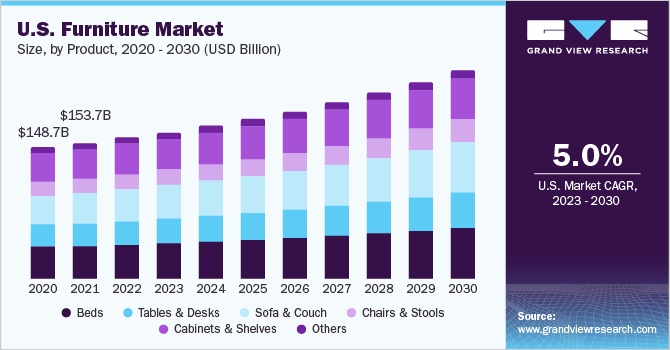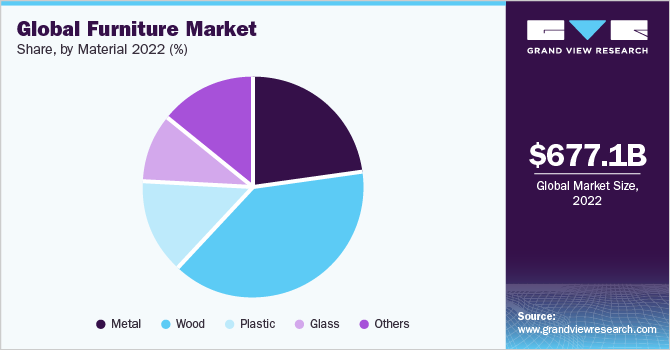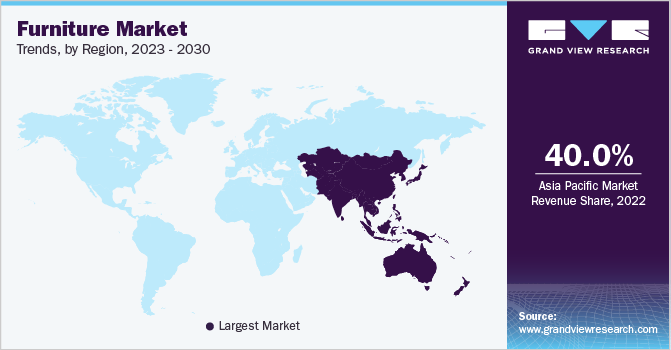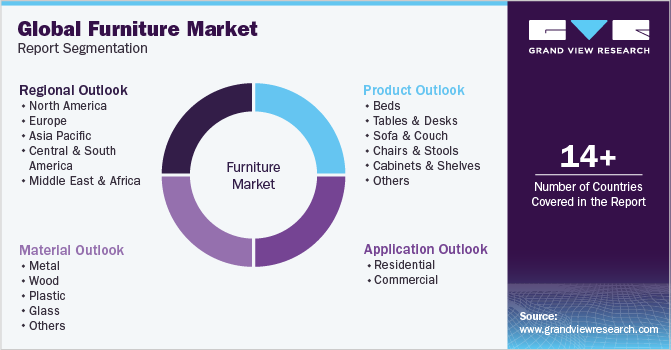- Home
- »
- Homecare & Decor
- »
-
Furniture Market Size, Share, Growth & Trends Report, 2030GVR Report cover
![Furniture Market Size, Share & Trends Report]()
Furniture Market Size, Share & Trends Analysis Report By Product (Beds, Tables & Desks, Sofa & Couch, Chairs & Stools, Cabinets & Shelves), By Material (Metal, Wood, Plastic, Glass), By Application, By Region, And Segment Forecasts, 2023 - 2030
- Report ID: GVR-2-68038-647-9
- Number of Report Pages: 84
- Format: PDF, Horizon Databook
- Historical Range: 2017 - 2021
- Forecast Period: 2023 - 2030
- Industry: Consumer Goods
Report Overview
The global furniture market size was valued at USD 677.09 billion in 2022 and is expected to grow at a compound annual growth rate (CAGR) of 5.9% from 2023 to 2030. The growth is driven by various factors such as increasing disposable incomes, growth of hospitality and housing sectors, developments in the commercial construction industry, and growing demand for premium and luxury furniture across the world. Moreover, the increasing capital investments in office infrastructure, primarily driven by the development of regional hubs in various countries, are expected to generate the need for office furniture during the forecast period. In 2020, according to the Economic Impact Study commissioned by the Building Owners and Managers Association of the U.S. (BOMA), the establishment of business offices in the U.S. is increasing.

However, the COVID-19 pandemic had a significant impact on consumer behavior as well as manufacturing trends in the furniture market. Owing to financial constraints that arose, consumers were reluctant to spend on non-essential items, including home interiors, and hence, the residential demand for furniture slumped. In the wake of the COVID-19 pandemic, there has been a slow but sure resurgence of housing projects and consumers are open to spending on household items once again, which is boosting the demand for furniture over the forecast period.
Moreover, various governments in the Middle East, especially Saudi Arabia’s government focus on the development of the real estate industry through various residential and commercial projects that will ultimately help to boost their economy. According to Saudi Arabia’s National Transformation Plan, the country has planned to build more than 555,000 residential units, approximately 275,000 hotel keys, over 4.3 million sq. meters of retail space, and over 6.1 million sq. meters of new office space expected by 2030.
Furniture not only supports and enables basic everyday functions such as sleeping and eating but has also been considered an essential element for home décor. Furthermore, purchasing furniture has become easier due to the availability of online platforms. FabFurnish, Pepperfry, and Urban Ladder are some of the popular e-commerce platforms for buying furniture in India. The rising demand for multi-functional and versatile products that provide portability and can easily be accommodated in small spaces is also accelerating industry growth. The increasing number of nuclear families has resulted in demand for portable and space-saving furniture products around the globe. This factor is anticipated to drive the demand for furniture.
Residential and infrastructural development, for instance, the establishment of churches or community centers, hospitals, and government institutes also impels product demand. Furthermore, government regulations regarding furniture, especially the products used in hospitals, require manufacturers to specially design and manufacture furniture that complies with government regulations. For instance, the British Contract Furnishing Association specifies that the wooden furniture in hospitals should be sealed with high-quality clear lacquer. The application of clear lacquer not only ensures durability but also includes antimicrobial agents that prevent the growth of micro-organisms.
Moreover, the positive outlook of consumers toward environmental protection is enabling various companies to introduce environment-friendly furniture. Cisco Home, Eco Balanza, Anton Doll Holzmanufactur, and Vermont Wood Studios are some companies engaged in offering high-end and eco-friendly furniture that is manufactured without any toxic carcinogens and chemicals. For instance, Cisco Home offers eco-friendly furniture through categories such as seating, bedroom, lighting, and other essentials. All the furniture offered by this company is made with non-toxic components and uses FSC-certified wood, which has led to its increased popularity in the residential segment.
Product Insights
In terms of revenue, beds dominated the furniture market with a revenue share of over 25% in 2022. Shifting consumer preference towards high-end furniture products owing to technological advancements in the home furnishing industry is a key factor driving the growth of the beds segment. Moreover, rising attention towards gaining trending bedroom styles has influenced major bedroom renovation projects and is expected to propel the market growth over the forecast period.
The sofa & couch segment is projected to register a CAGR of 7.1% from 2023 to 2030. the increasing wave of millennials buying homes, particularly older homes, which require more refurbishment, is boosting the growth of the sofa and couch segment across the globe. According to studies by HomeAdvisor, millennials are investing in a greater number of home improvement projects each year compared to other age groups. This may propel the growth of the market growth over the forecast period.
Material Insights
In terms of revenue, the wood segment held the dominant industry share of around 40% in 2022. This growth is anticipated to accelerate as wood is one of the naturally available raw materials and is used in the production of almost all types of furniture products around the world. Wooden furniture is primarily produced by processing raw timber. Additionally, the three main categories of wooden panels are plywood, fiberboard, and particleboard.

The plastic segment is estimated to grow with the fastest CAGR of 7.0% over the forecast period. Rapidly increasing demand for low-priced designer furniture across the globe is accelerating market growth. Moreover, the increasing demand for high-performance plastic material is expected to surge rapid growth of the market in the upcoming years. Furthermore, manufacturers are launching innovative and well-designed plastic furniture to accelerate the lucrative growth of the industry over the forecast period.
Application Insights
The residential segment contributed to the largest revenue share of over 60% in 2022 and is expected to grow with a CAGR of 5.7% from 2023 to 2030. The residential segment is projected to proliferate over the forecast period due to increasing demand for furniture in the living room and bedroom coupled with rising real estate construction projects initiated by governments, especially in urban areas. For instance, the Ministry of Housing and Urban Affairs in India is responsible for initiating and approving infrastructure development in urban towns and other metropolitan cities of India.
The commercial segment is expected to grow at the fastest CAGR of 6.2% from 2023 to 2030. High demand from offices and hotels is projected to bode well for the expansion. Rising demand for office space and expanding the hospitality sector can further be fueling the demand for products. Furthermore, the rising furniture requirement in restaurants, coffee shops, and bars, among others is also accelerating the market growth.
Regional Insights
The Asia Pacific dominated the furniture market with a share of around 40% in 2022. This growth can be accredited to the increasing disposable income of the upper and middle-class population. Moreover, the increasing demand for living room furniture followed by bedroom and kitchen and dining furniture is projected to accelerate the market growth. In addition, the growth is driven by the booming real estate industry coupled with government-initiated housing projects. Furthermore, the rapid urbanization coupled with the growth of the IT industry in this region is expected to propel market growth over the forecast period.

Middle East & Africa is expected to witness a second-fastest CAGR of 6.2% from 2023 to 2030. The growth of the regional industry can be attributed to several countries, including the UAE and Saudi Arabia, which are investing aggressively in developing infrastructure to attract international tourists and create opportunities for economic growth. For instance, in Dubai, the government is expected to invest significantly in infrastructure to attract a large number of visitors. This is a contributing factor to regional industry growth.
Key Companies & Market Share Insights
The market is characterized by the presence of a few established players and new entrants. Many big players are increasing their focus towards growing trend of furniture. Players in the market are diversifying the service offering in order to maintain market share.
-
For instance, in March 2020, La-Z-Boy Incorporated announced that the company had acquired the business that operates six independently owned La-Z-Boy Furniture Galleries stores, with approximately USD 30 million in annual retail volume, and one warehouse in the Seattle, Washington
-
For instance, in December 2021, Empire Office, Inc. announced that the company entered into an agreement to acquire DeKalb Office Environments, Inc., establishing its local presence in Atlanta and Birmingham
Some of the key players operating in global furniture market include: -
-
IKEA
-
Ashley Furniture Industries Inc.
-
RH (Restoration Hardware)
-
Williams-Sonoma, Inc.
-
La-Z-Boy Inc.
-
Raymour & Flanigan
-
American Signature
-
Oppein Home Group Inc.
-
Jason Furniture (HangZhou) Co., Ltd
-
Steelcase Inc.
Furniture Market Report Scope
Report Attribute
Details
Market size value in 2023
USD 709.46 billion
Revenue forecast in 2030
USD 1,070.87 billion
Growth Rate
CAGR of 5.9% from 2023 to 2030
Base year for estimation
2022
Historical data
2017 - 2021
Forecast period
2023 - 2030
Report updated
August 2023
Quantitative units
Revenue in USD Million and CAGR from 2023 to 2030
Report coverage
Revenue forecast, company ranking, competitive landscape, growth factors, and trends
Segments covered
Product,material, application, region
Regional scope
North America, Europe, Asia Pacific, Central & South America, Middle East & Africa
Country scope
U.S., Canada, Mexico, U.K., Germany, France, Italy, Spain, China, Japan, India, Australia, South Korea, Brazil, South Africa
Key companies profiled
IKEA, Ashley Furniture Industries Inc., RH (Restoration Hardware), Williams-Sonoma, Inc., La-Z-Boy Inc. , Raymour & Flanigan, American Signature, Oppein Home Group Inc. , Jason Furniture (HangZhou) Co., Ltd, Steelcase Inc.
Customization scope
Free report customization (equivalent up to 8 analysts working days) with purchase. Addition or alteration to country, regional & segment scope.
Pricing and purchase options
Avail customized purchase options to meet your exact research needs. Explore purchase options
Global Furniture Market Report Segmentation
This report forecasts revenue growth at global, regional & country levels and provides an analysis on the latest trends and opportunities in each of the sub-segments from 2017 to 2030. For the purpose of this study, Grand View Research has segmented the global furniture market on the basis of product, material, application, and region.

-
Product Outlook (USD Million; 2017 - 2030)
-
Beds
-
Tables & Desks
-
Sofa & Couch
-
Chairs & Stools
-
Cabinets & Shelves
-
Others
-
-
Material Outlook (USD Million; 2017 - 2030)
-
Metal
-
Wood
-
Plastic
-
Glass
-
Others
-
-
Application Outlook (USD Million; 2017 - 2030)
-
Residential
-
Commercial
-
-
Regional Outlook (Revenue, USD Million; 2017 - 2030)
-
North America
-
U.S.
-
Canada
-
Mexico
-
-
Europe
-
U.K.
-
Germany
-
France
-
Italy
-
Spain
-
-
Asia Pacific
-
China
-
Japan
-
India
-
Australia
-
South Korea
-
-
Central & South America
-
Brazil
-
-
Middle East & Africa (MEA)
-
South Africa
-
-
Frequently Asked Questions About This Report
b. The global furniture market was estimated at USD 677.09 billion in 2022 and is expected to reach USD 709.46 billion in 2023.
b. The global furniture market is expected to grow at a compound annual growth rate of 5.9% from 2023 to 2030 to reach USD 1,070.87 billion by 2030.
b. Asia Pacific region dominated the furniture market with a share of over 37.6% in 2022. This is owing to the rising income levels across the region, and the booming real estate industry coupled with government-initiated housing projects.
b. Some key players operating in the furniture market include IKEA, Ashley Furniture Industries Inc., RH (Restoration Hardware), Williams-Sonoma, Inc., La-Z-Boy Inc., Raymour & Flanigan, American Signature, Oppein Home Group Inc., Jason Furniture (HangZhou) Co., Ltd, and Steelcase Inc.
b. Key factors that are driving the furniture market growth includes increasing disposable incomes, growth of the hospitality and housing and commercial construction industry, and growing demand for premium and luxury furniture from certain customers across the globe.
Share this report with your colleague or friend.
![gvr icn]()
NEED A CUSTOM REPORT?
We can customize every report - free of charge - including purchasing stand-alone sections or country-level reports, as well as offer affordable discounts for start-ups & universities. Contact us now
![Certified Icon]()
We are GDPR and CCPA compliant! Your transaction & personal information is safe and secure. For more details, please read our privacy policy.
We are committed towards customer satisfaction, and quality service.
"The quality of research they have done for us has been excellent."





